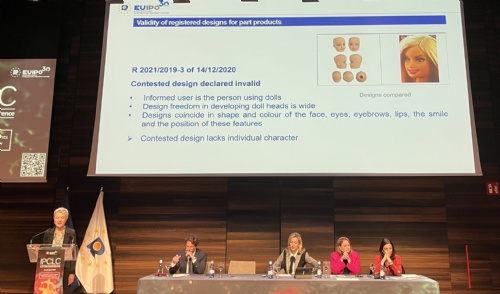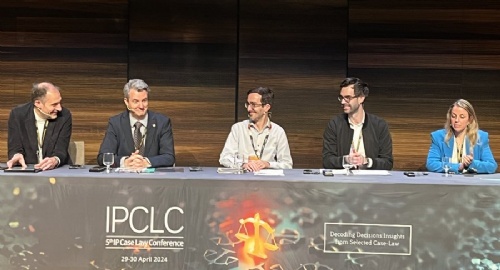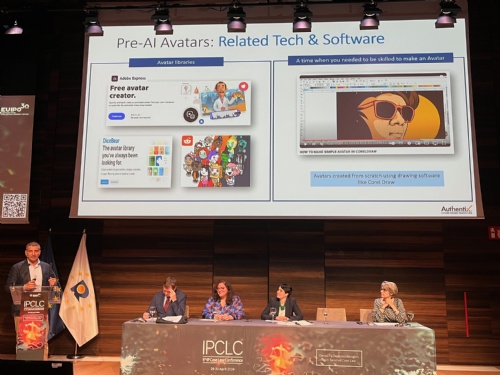Now in its twelfth year, Class 46 is dedicated to European trade mark law and practice. This weblog is written by a team of enthusiasts who want to spread the word and share their thoughts with others.
Click here subscribe for free.
Who we all are...
Fifth IP Case Law Conference - report on panels 2, 3 and 4
Several MARQUES members are taking part in the Board of Appeal IP Case Law Conference at EUIPO this week. In this second post, we report on three panels held on day one.
Case law on designs
 The conference’s second panel looked at latest developments in design case law. The panel leader was Maja Praljak - Judge of Commercial Court in Zagreb, who said that “designs are my favourite topic!”
The conference’s second panel looked at latest developments in design case law. The panel leader was Maja Praljak - Judge of Commercial Court in Zagreb, who said that “designs are my favourite topic!”
Dr Iván L Sempere - Founding partner of PADIMA discussed “Beyond product safety and technical constraints: Challenges of standardized or ‘common’ design features”. He said the starting point is that standardised features become common, impacting the designer’s freedom. “How can we identify the constraints and what impact do they have on the individual character assessment?” he asked.
Dr Sempere stressed the aim of the regulation is to promote design innovation and three legal concepts are important: the overall impression, informed user and degree of freedom of the designer. “When a designer has to follow certain statutory constraints, some features of the design become mandatory and there is no choice for the designer to design differently. This is something that is objective.” For example, in the EU mobile phone cables must all be designed the same way.
But, he asked, are there other potential reasons behind the standardisation of features, such as fashion trends? “The existence of disruptive innovation shows the designer had the choice to design differently,” said Dr Sempere. He argued that only minor importance should be attached to common features, whatever the reason for them: “Users pay less attention to the common than the uncommon.”
In “From Ferraris to Barbie doll heads: Dilemmas of designs of part products”, Elisabeth Fink - Member of the First and the Third Boards of Appeal, EUIPO, discussed the assessment of individual character. In the Barbie dolls case (T 84/21), the General Court confirmed that the design was invalid based on prior-disclosed dolls. In a case concerning saucepan handles, they differed in immaterial ways and were also invalid.
However, in the Ferrari case which concerned front kits (case C-123/20), the CJEU said that designers are not required to make available separately each of the parts of a product to benefit from protection. The Court stated: “in order to assess the conditions for protection as a Community design, the part of the product or component part of the complex product at issue must be visible and defined by features which constitute its particular appearance, namely by particular lines, contours, colours, shapes and texture. That presupposes that the appearance of that part of the product or that component part of a complex product is capable, in itself, of producing an overall impression and cannot be completely lost in the product as a whole.”
Ms Fink said that, in her view, the same principle that designers should make available separately each part should also apply to prior art. The capability of producing an overall impression should be a criterion to identify a part product within the whole product and the assessment of validity should be based on the part product as identified by the invalidity applicant.
Disclosure in high-tech globalized environments under Article 7(1) was the subject of a presentation by Eva Maierski – Partner at Lubberger Lehment and member of the MARQUES Designs Team. She noted that the “public disclosure” is in principle “pretty broad” but is qualified by the “reasonable awareness” (specialised circles) test.
“In the globalised world we live in, the scope of prior art is pretty big” said Ms Maierski, and encompasses websites, online product launches, blogs and social media. She highlighted the Rihanna case (T-647/22) in which the designs were invalidated based on pictures on the singer’s Instagram account as they were relevant and sufficient disclosure, and a case concerning chair designs based on prior art on amazon.de, which included the disclosure date (T-89/22). “It seems that the General Court is a bit more realistic about the reliability of disclosed data,” she said and added that challenging the reliability of the data is up to the right holder.
“Online publications play a crucial role and increase the scope of potential prior art,” said Ms Maierski. This means finding a balance between the disclosure and the filter test. “We also need to question the reliability of online disclosures a bit more,” she added.
Finally, Dr Astrid Graul – Legal Department, DG Grow, European Commission covered “Incoming waters: The latest on the Design Legislative Reform”. She reviewed the development of design law in Europe. Formal adoption is now expected in September/October this year.
She said that about 80% of the Commission’s proposal was accepted by the co-legislators, and the result makes the design system future-proof, accessible and efficient, meeting stakeholder needs and not over-interfering with the current system. Critically, it also addressed the spare parts issue with the repair clause.
“There are a lot of benefits and improvements for applicants,” she said. These include a simplified fee structure, the abolition of the unity of class requirement and a fast-track invalidity procedure.
New trade mark challenges
 The twilight zone was the subject of the first speech in a panel on new trade mark challenges. It was given by Yann Basire - Director General of CEIPI and Director of the French section of CEIPI, who looked at the “law of permissible variations”. He noted that this right is strange insofar as it benefits the trade mark owner rather than third parties.
The twilight zone was the subject of the first speech in a panel on new trade mark challenges. It was given by Yann Basire - Director General of CEIPI and Director of the French section of CEIPI, who looked at the “law of permissible variations”. He noted that this right is strange insofar as it benefits the trade mark owner rather than third parties.
He said that case law has considered that the two marks must be “globally equivalent”. There are two steps: What is considered distinctive about the registered mark? What are the differences with the mark as used and what is the impact of the variations?
He discussed recent decisions including Steam T-609/21, Kasite (fig) T-323/21, shape of a baby’s bottle T-273/21, Gourmet T-102/22 and th pharma (fig) T-27/22 as well as cases involving the addition of a single letter (T-55/23 and T-562/22) and omission of letters (T-512/21, T-615/20 and T-645/22). Other differences include grass in bottle T-796/16 and Bear T-638/21.
“These examples show that the issue is difficult. We can question the notion of the dominant element … Alteration implies significant modification of the sign should be at the heart of the reasoning,” he said, adding that with the introduction of multimedia marks: “It’s not excluded we’re moving further into the twilight zone.”
Christoph Bartos - Member of the First and the Third Boards of Appeal, EUIPO, spoke about “Avoiding arbitrariness: The role of subcategories in genuine use”. He said the case law is clear on the principles but less so on the specifics. He discussed cases T-242/22, T-585/22, T-474/21, R 2595/2015-G, T-63/22, C-714/18 P, T-589/20, T-562/22, T-603/22 and T-161/23.
“The criteria are more or less consistent … but the application is incoherent and that is the biggest problem,” said Mr Bartos. “My question is regarding arbitrariness: if we have specific goods, is it always the same subcategory or can we establish on the facts different subcategories?”
Non-conventional trade marks were the subject of the talk by Nedim Malovic - Trademark/IP Counsel at Assa Abloy. He focused on technical functionality and inherent distinctiveness, saying the past few years have seen an increase in case law on this topic, for example cases C-205/13 Hauck, R 850/2022-1 Rubik’s Cube and T-325/18 wine bottle.
The Rubik’s Cube was centred on “necessary to obtain a technical result”. Another interesting case on functional grounds was T-10/22 Wajos, where a mark that had been held to be distinctive nevertheless was regarded as functional. When it comes to inherent distinctiveness, it may harder to establish for a figurative or pattern mark.
“Only a mark consisting of the appearance of a product itself which significantly diverges from the norms and customs of the sector is not devoid of distinctive character,” he said. This makes it very hard to register non-conventional trade marks.
Finally, Desirée Russo - Trademark Counsel for PUMA SE provided an in-house perspective on the challenges of revamping trade marks, drawing on the development of Puma’s logos, brand and ambassadors. “Securing trade mark protection has not always been easy. We have faced difficulties in particular in Spain where a manufacturer copied all our branding. We eventually got all these trade marks transferred.”
She stressed the importance of ambassadors in creating a trustworthy bond with consumers as well as collaborative marketing with many partners in sport, fashion, music and entertainment. The brand recently celebrated its 75th anniversary.
“It is possible to revamp great trade marks,” she said. “The main factor is the willingness to preserve material and immaterial heritage based on the brand values.”
The panel was led by Augusto Drumond – Principal Legal Counsel, EU IP OPERATIONS, Amazon and member of the MARQUES EU Trade Mark Law and Practice Team.
IP code-breaking
 Noemi Parrotta – Partner, Attorney at law at Spheriens led the day’s final panel on IP code-breaking in the era of AI advancements.
Noemi Parrotta – Partner, Attorney at law at Spheriens led the day’s final panel on IP code-breaking in the era of AI advancements.
Hugh O’Neill - Head of Legal Practice Service, EUIPO discussed IP in NFTs and Cryptocurrency – On the origin of “specie”. He said that NFTs are unique digital assets which can be linked to digital or physical items. “An NFT only makes commercial sense when it’s linking to something other than itself,” he explained.
When performing the function of authentication, NFTs are classified according to what they authenticate. EUIPO published guidance on this nearly two years ago. When considered as a technology, the classification is slightly different.
Turning to cryptocurrencies, Mr O'Neill said there are many of them but the key is that they are decentralised. “That means I can’t detect the point of control in a trade mark sense,” said Mr O’Neill. He asked whether these new blockchain-based technologies are alien and whether the trade mark system needs to be adapted to accommodate them.
Avv Emanuela G Zapparoli - Counsel at Nunziante Magrone addressed these questions as they apply to IP professionals and judges. She discussed the Birkin bags NFT case in the United States which opened the door for trade mark owners to assert rights in the digital realm, the Juventus case in Italy and a case involving Laviniah Deborah Osbourne in the UK.
“When we come to copyright protection we have much bigger issues,” she said. These include authorship in the Italian RAI v Chiara Biancheri case and training data for AI in the US Andersen v Stability AI cases.
“We are at the frontiers of new challenges in both copyright and trade mark protection,” said Ms Zapparoli. “What is required is to really understand how these technologies work and be proactive.” This includes securing protection and/or evidence to prove infringement.
Where are we in terms of avatars? asked Bharat Kapoor – Vice President, Authentix, who shared some of his own avatars. He pointed out that Eternity is an AI-generated K-pop band with nearly 25 million subscribers on social media.
Open-source software enables anyone to create AI avatars. This raises challenges including use of IP without permission, fake endorsements, deepfakes and deepnudes, bias and piracy. Mr Kapoor added that, despite having policies in place, many platforms see high levels of infringement.
Finally, Sarah Bailey - Avocat à la Cour, Partner at Simmons & Simmons LLP provided 10 steps to protecting IPR in cyberspace:
- Understand the technology
- Leverage the technology
- Implement technical protection
- Register IP to cover cyberspace
- Negotiate licences with cyberspace players
- Monitor cyberspace to spot infringements
- Prepare to enforce rights against cyberspace infringements
- Lookout for technical, judicial and legal evolutions
- Be creative and ready to adapt strategy
- Don’t hesitate to reach out to an IP expert
Posted by: Blog Administrator @ 16.04
Tags: IPCLC, EUIPO, General Court,


 Sharing on Social Media? Use the link below...
Sharing on Social Media? Use the link below...Perm-A-Link: https://www.marques.org/blogs/class46?XID=BHA5265

